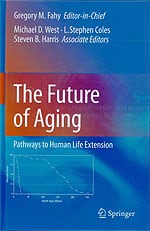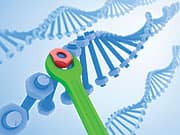Life Extension Magazine®
Last year, the minds at Life Extension® and a host of other scientific and medical research organizations came together to produce The Future of Aging—Pathways to Human Life Extension. This project is much more than just a guidebook: it can literally be taken as a visionary blueprint for extending our life span and redefining our place in a radically transformed society, as predicted by the best brains in the science of aging. Aging research (biogerentology) has seen staggering exponential advances in the last decade, but the contributors to The Future of Aging have come together for the first time in a single volume to make the convincing case that we are still in the beginning stages, and indeed the best is yet to come. They assert that we are in the midst of a crucial period in the study of aging: millions of post-World War II Baby Boomers are about to enter the American long-term health care system, and the economic costs could potentially cripple an already severely strained economy. Accordingly, this guide is not only indispensable; the timing for it has never been more urgent. Aging Intervention: Easy First StepsThe Future of Aging begins with nutrition, exercise, and supplementation as basic first steps to extending life. Writer and inventor Raymond Kurzweil, author of several books on futurism, employs a “bridge” metaphor, adopting present-day therapies to enable people to remain healthy long enough to take advantage of later advancements. Kurzweil cites modified caloric restriction (CR) as a proven viable method of increasing life span across a broad range of animal species. “Free radicals cause a gradual deterioration of body tissues, particularly fragile cell membranes,” explains Kurzweil. “CR test animals have significantly lower levels of free radicals, so they also have less free-radical damage to their cell membranes. Extrapolating animal studies to humans, some researchers have estimated that our maximum life span might be extended from 120 to 180 years,” he concludes. Exercise, says Kurzweil, is a basic tool of life extension that everyone can and should be utilizing. He cites an eight-year study that logged a 60% lower overall death rate for even moderate exercisers, particularly with respect to cardiovascular disease. “Even as little as 30 minutes a day can provide significant benefit,” he says. “Despite this, some 70% of Americans do not participate in any type of physical activity.” Likewise, nutritional supplementation can overcome depleted levels of vitamin and mineral content resulting from modern farming methods, long linked with premature aging of human bodies. Michael R. Rose, professor in the Department of Ecology and Evolutionary Biology at the University of California, Irvine, takes Kurzweil’s notion a huge leap further: Rose and his research colleagues suggest that the best future strategy for radically extending human life span several-fold may well be nutritional supplementation. “Evolutionary nutrigenomic agents,” Rose believes, “can emulate the process of natural selection, using nutritional supplements in lieu of genetic variation.” Solutions Already Inside UsCryobiologist and biogerentologist Gregory M. Fahy, originator and editor-in-chief of The Future of Aging, goes beyond Kurzweil’s basic recommendations to suggest that resources for basic control over aging in fact reside in our own genomes. Citing examples of “zero aging” in certain species of juvenile mollusks and insects that wait for biochemical signals to develop into their mature forms, Fahy believes aging is not only malleable, but even preventable and reversible in mammals.
“The ability of many species to sustain a nominally zero aging state even as adults indicates that aging is not a fundamentally inescapable process,” says Fahy. The key, he believes, will be gaining interventional control over how and when these signals are expressed. Building on the idea of biological control, biotechnology entrepreneur Michael D. West feels the neglect of stem cell research is a specific example of the dearth of medical research in gerontology in general. “Many researchers quickly ascribe the aging process to entropy, and then just conclude that reversing aging is, for all practical purposes, impossible,” West comments. He feels these conclusions ignore the fact that the lineage of germ-line cells, unlike their somatic counterparts, replicate in an immortal process of cell division. “This means that these cells must possess sufficient repair mechanisms to allow enough individuals to survive in order to perpetuate their species,” he says. Scouting Killers and Rewriting DNA“If we strive for life extension in humans, it will be nearly impossible without solving the biggest challenge that shortens human life span most inexorably today,” says Zhen Cui, biochemist and assistant professor of pathology at Wake Forest University. “In plain words, if we don’t solve the cancer problem, it will be very difficult to think about healthy life extension in meaningful terms.” Before cancer can be treated, it must obviously be detected. To that end, Cui envisions a cancer surveillance system, utilizing the body’s own immune defenses. Granulocytes, a category of white blood cells, are the first line of defense in the human immune system, explains Cui; they are the first to arrive at sites of infection, wounds, or neoplasia (malignant abnormal cell growth), fighting off and limiting damage. “In the mid- to late 1800s, clinicians noticed a profound association between bacterial infections and miraculous regressions of incurable malignancies,” he says. “Nowadays, we know that a common theme of human response to all bacterial infections is a massive increase of human granulocytes entering the circulation within days or even hours.” Aggressive cancer cells are always metabolically active, with a negative surface charge similar to bacteria. Cui surmises that this trait makes them ideal targets for neutrophils, the most abundant type of granulocyte. In effect, the neutrophils could be used to “tag” cancer cells, functioning as a type of early warning system.
There is evidence that nearly all age-related illnesses involve some degree of damage to DNA. The advances in genetic engineering in the last decade offer great potential for the treatment of acquired or inherited genetic disorders associated with aging, says Clifford Steer, a University of Minnesota professor in the Department of Medicine, Genetics, and Cell Development. Gene repair, says Steer, has several advantages over other regenerative approaches in terms of potential therapeutic benefit. “Most importantly, it allows for the correction of single-point gene mutations without impacting functional regions of the gene,” he explains. What the Future HoldsRobert A. Freitas, Jr., senior research fellow at the Institute for Molecular Manufacturing, believes nanorobotic control of human aging—a technology once relegated to the realm of science fiction—is now of great relevance to our present-day medical reality. “The comprehensive knowledge of human molecular structure, so painstakingly acquired during the previous century, will be extended and employed in this century to design medically active microscopic machines,” Freitas forecasts. These machines, rather than being tasked with discovery, will be sent on missions of cellular inspection, repairing and reconstructing whole cells. Moreover, Freitas predicts that systems based on nanomachines will be “more compact and capable than those found in nature.” Nanotechnology, the control of the composition and structure of molecular material at the atomic level, involves the engineering of precise structures and, ultimately, molecular machines. The prefix “nano” refers to their scale, a nanometer being one-billionth of a meter, or the width of five carbon atoms. Challenges inherent in micron-scale sources of energy and propulsion methods still need to be overcome, and questions of biocompatibility present further problems—e.g., whether a human immune system can recognize medical nanorobots. But with the global market for nanodevices expected to reach $8.6 billion this year, demand will be the technology’s greatest impetus.
Kurzweil supports Freitas’ projections, adding that Freitas is already ahead of the curve: “Freitas has designed a nanorobotic red blood cell which is a relatively simple device for storing and releasing oxygen and carbon dioxide,” he says. “A conservative analysis shows that if you were to replace ten percent of your red blood cells with these robotic versions, you could do an Olympic sprint for 15 minutes without taking a breath, or sit at the bottom of your pool for four hours.” Attainable VisionsTaken as a whole, the visions described here represent just a fraction of alternate pathways toward the goal of extending human life, with each method showing equal promise. As with most plans, one step may be inextricably interlinked with another, so that several interventions work in tandem. “Truly effective intervention into aging is likely to require a multiplicity of interventive strategies, and this will remain a significant challenge for some time,” says Fahy. There is no question that we are learning how to intervene in the process, and that process is accelerating. In the prophetic words of the contributors, the future of aging will begin to arrive sooner than we think. If you have any questions on the scientific content of this article, please call a Life Extension® Health Advisor at To order The Future of Aging—Pathways to Human Life Extension, or call 1-800-544-4440 |





